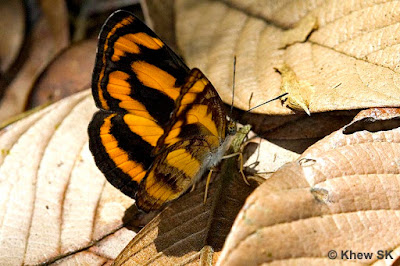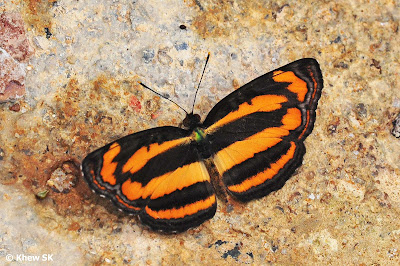The Year in Review
A Banded Royal perches atop a fern, contemplating the year ahead
The year 2020 will most certainly go down in history as a year "where the world came to a standstill". Or as some would prefer to call it a "Reset Year". COVID19, a coronavirus that purportedly originated in the city of Wuhan in China, wreaked so much havoc across the world that one will wonder if life would ever be "normal" again? This mother of all disruptions affected the entire world and across all seven continents. Cities were locked down, businesses severely impacted, economies foundered, livelihoods were threatened, and lives lost.
A Common Mime feeding at the red flowers of the Javanese Ixora
It was also a year where we saw, read about and for some of us, personally experienced the best and worst of humankind. At one end of the spectrum, we saw the rush for provisions in supermarkets and shopping centres. The ubiquitous toilet paper mystery threw up many theories about why this humble household product is often the first to disappear from shelves! But we also saw acts of human kindness and gestures that would certainly "warm the cockles of ones' hearts".
A newly-eclosed Common Birdwing hanging onto the flower spike of the Pink Snakeweed
In Singapore, the government was quick to act to manage the virus initially, but did not predict the surge in infections in the foreign worker community, which created a scare, with the rapid escalation of the numbers of COVID-positive individuals on the island. But swift, hard decisions were made, and the situation finally came under control after several nail-biting months.
In 2020, this blog started off by introducing our urban butterflies, common species that can be seen in our urban parks and gardens. Species that most people would be able to encounter in residential areas, parks and park connectors and urban green spaces. Six species were featured, and these are probably the easiest to spot, even in downtown CBD - such is our City In a Garden (and moving to a City In Nature), where biodiversity thrives.
Our Butterflies of the Month series continued in 2020, featuring another 12 species, and bringing the total to 158 species of butterflies that make Singapore their home. This series, which started with the Malay Lacewing in as the feature butterfly back in December 2007, has continued for the past thirteen years and features each species in greater detail, showing the excellent photographs contributions by the photographers in ButterflyCircle's forums and social media platforms.
We continued our series of articles on the collective groups of butterflies known by their English common names. This year, we showcased the Nawabs, Emigrants, Line Blues, Plushblues, Eggflies, Bush Browns and Lascars found in Singapore. Known by their collective English common names, these articles compared the individual species in these groups of butterflies, some of which are very similar in appearance. Diagnostic features elaborated in the articles helped to distinguish and ID them in the field.
A special blogpost was dedicated to the Lunar New Year butterfly teacup series that ButterflyCircle members contributed photos to. The 2020 edition of the teacup featured the urban sun-loving species, the Blue Pansy. This completes the collection of six teacups from 2015-2020 and they will be complemented with a teapot to complete the entire set in 2021. Special thanks to Ms Ho Ching for giving ButterflyCircle members the opportunity to showcase and immortalise their work in this teacup set.
We discussed the morphology of butterflies in the article on polymorphism, where the various forms, both males and females were investigated. Some of the reasons for the different morphs were offered for discussion - like mimicry to avoid predation, or even environmental reasons. Another article asked questions about certain species of butterflies in Singapore where variants are so consistent that whether there is a possibility that they have become morphs or forms of the same species?
Despite the imminent danger of the COVID19 pandemic, five members of ButterflyCircle had already planned an overseas outing to Mahua in the state of Sabah in East Malaysia. After considering the various options and weighing the risks, and as it was still uncertain as to the state of unprecedent measures that were to come later, we decided to go ahead with the trip in early February. Even though there were still no travel restrictions back then, we still took all the precautions of wearing facemasks on the trip there and back.
It was a relatively fruitful outing to Mahua (for some of us, a 2nd trip there). Hunting down the Bornean endemics was fun, and we managed to get a few of them on our hit list. A few of the subspecies looked quite different from the Singapore and Malaysian species, and we took our fill of photos on that 7D/6N trip. This time around, we explored a few other locations that could be fruitful locations for butterfly shooting on future trips.
Then we featured more plant-butterfly relationships with four articles. Two favourite nectaring plants articles were added to the series with our feature plants/flowers of the Globe Amaranth and the Blood Flower. Then we discussed the importance of Mistletoes (parasitic plants) to a variety of butterfly species, and the unique Danainae-attracting Rattlebox Plant and the interesting behaviour of the Tiger and Crow butterflies to extract the fluids from different parts of the plant.
Two blogposts featured some non-native or exotic butterflies - some of which have become common resident species in Singapore. There was also a discussion on the baseline checklists and what came to be defined as a non-native species to Singapore is largely based on the works of the early authors. These "exotics" range from those that could have flown in from neighbouring Malaysia, to those species that may have migrated from faraway geographies like India, Sri Lanka and even all the way from the US!
Butterfly procreation was the next topic on the cards, and we featured the article in two parts, with plenty of photos of butterflies "doing it". We also asked questions that would prompt more observations of these mating pairs - like "which of the two sexes does the flying when they are paired?" or "how long can they sustain their flight as the one flying has to carry about twice its usual weight?". Whilst there may be no hard and fast answers, more field observations may shed further light on the behaviour of butterflies.
A scientific paper was featured in the blogpost "Hidden in Plain Sight" which described the important discovery that was somehow overlooked for a long time - that the female Malay Staff Sergeant was actually orange in colour, and that the species was all this time sexually dimorphic! How this fact could have been overlooked for so long is amazing. And it is thanks to Horace Tan who stumbled on this when he was documenting the species' life history, and with the scientific rigour of Dr Laurence Kirton and Dr Phon Chooi Khim, this misidentification has now been corrected in a paper published in the Raffles Bulletin.
The COVID19 pandemic was in full swing by mid-year, and many observers noticed that the lack of maintenance workers and grass cutters resulted in many areas of Singapore overgrown with wild flowers (or what would be considered weeds). With abundant host and nectaring plants, the number of butterflies in urban areas increased significantly, prompting many nature lovers to opine that perhaps we should allow areas with minimal grass-cutting and pruning to conserve our local butterfly (and other insect) biodiversity.
Over many years of butterfly watching and photography also yielded observations of how Crab Spiders lay in wait for unsuspecting butterflies flitting from flower to flower. Many butterfly photographers have collected photos of dead butterflies at the jaws of these stealthy predators, waiting and camouflaging themselves amongst the flowers that the butterflies visit.
Our Life History expert, Dr Horace Tan returned this year to document the early stages of 3 species in his usual meticulous style which sets the gold standard for how the documentation of egg-to-adult should be done. We have, thus far, documented a total of 198 species' life histories on this blog, the majority of which is Horace's hard work. Three species, the Malay Staff Sergeant, Ciliate Blue and the Banded Royal were featured in 2020.
Two of our public parks that are relatively good butterfly watching and shooting locations were featured this year. These parks are part of the Southern Ridges parks and form a series of linear parks that are interconnected. These parks, Kent Ridge Park and Telok Blangah Hill Park, have yielded some surprises in the past. Hill-topping activity occasionally brings rare Lycaenidae and Nymphalidae to these elevated parks.
And then a vagrant Swamp Tiger caused a bit of an excitement when it was spotted on Pulau Ubin in August this year. Typically a mangrove resident in Malaysia, e.g. Kuala Selangor Nature Reserve, a female Swamp Tiger was observed at Butterfly Hill on Pulau Ubin. We then updated our "Flying Tigers" article to add in the new discovery, and to record that we have 10 species of these "Tigers" in Singapore to date.
Along the lines of new discoveries and re-discoveries, we featured some species that are extant in Singapore, were even common at some point in time, but then suddenly disappeared for many years. What happened to these species? Were they displaced by development? Or something happened to the habitats or host plants that they prefer? Are there conservation efforts or lessons that we can glean from such observations where interventions can help save these species?
I "celebrated" the milestone of my 1000th article on this blog (on 11 Oct 2020). It had been a long and determined journey that I resolved to contribute a minimum of a post per week on this blog. Just to share information, knowledge and technical knowledge about butterflies, to the best of my ability. I also mentioned that come 2021, I will slow down (but not stop altogether) the articles on this blog. I will just keep to the articles on the Butterfly of the Month, and then post any articles of interest as and when any new information is available. Horace Tan will also have a few incomplete life histories that should be completed and these will be posted to create the repository of the best available information on Singapore's Butterflies' life histories on any digital platform.
It has been a worthwhile and fulfilling journey of blogging for the past 13 years, and I would like to humbly thank members of ButterflyCircle, especially Horace Tan and Mei Yee who helped contribute many articles on the blog, and all the photographers whose excellent work made the blog posts come alive. I would also like to sincerely thank the small group of supporters from Singapore, and all around the world. I am grateful that some of you have dropped in once in awhile to pen your words of encouragement and appreciation for the articles posted and a few have even given suggestions for new areas to explore and/or write about. This blog will remain as a repository of information and articles about butterflies, albeit at a much slower pace from here on.
I would like to take this opportunity to wish all readers in Singapore and all around the world a Happy (and hopefully COVID-free) 2021!!!
Text by Khew SK : Photos by Janice Ang, David Chan, Bob Cheong, Sunny Chir, Huang CJ, Khew SK, Koh CH, Lim CA, Loh MY, Loke PF, Simon Sng, Jonathan Soong, Horace Tan, Anthony Wong and Mark Wong

























































